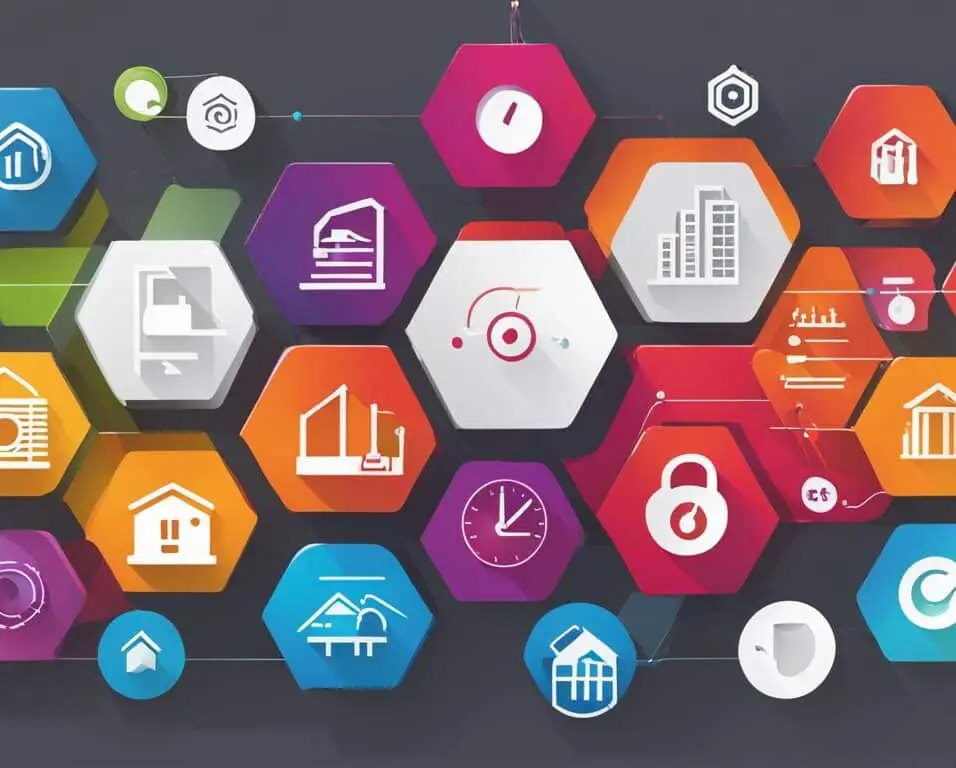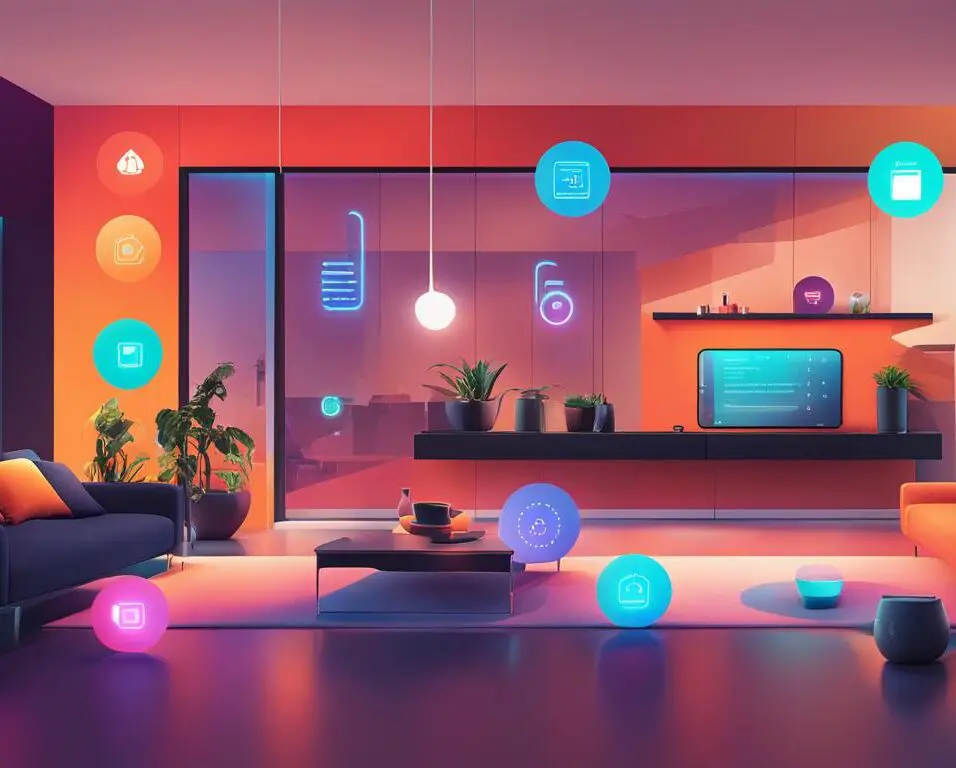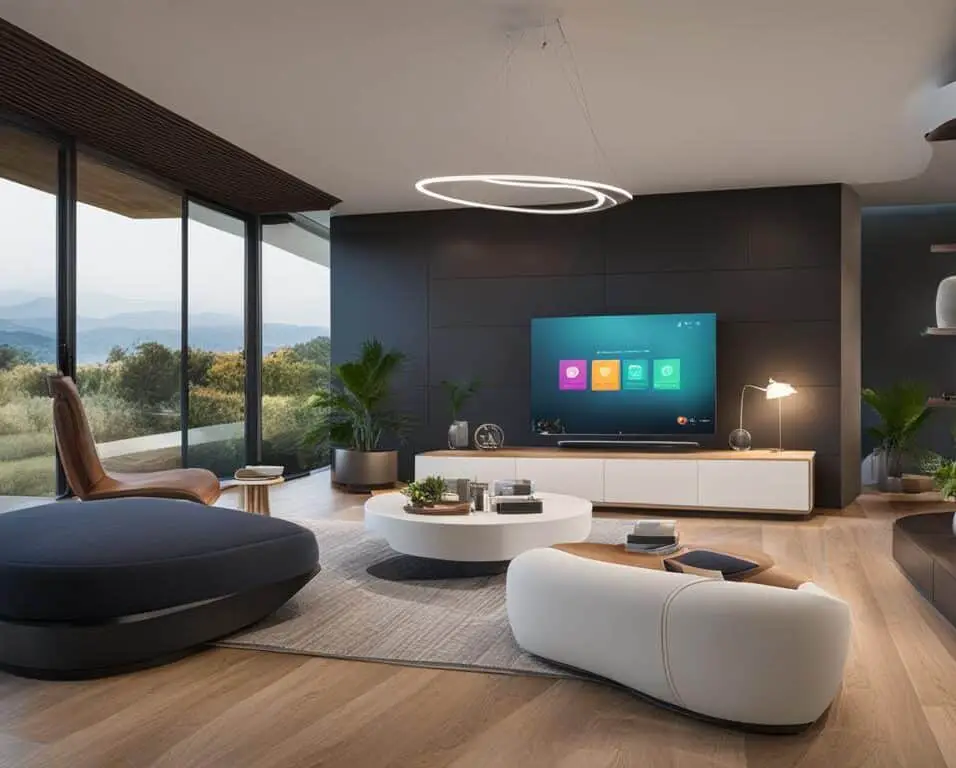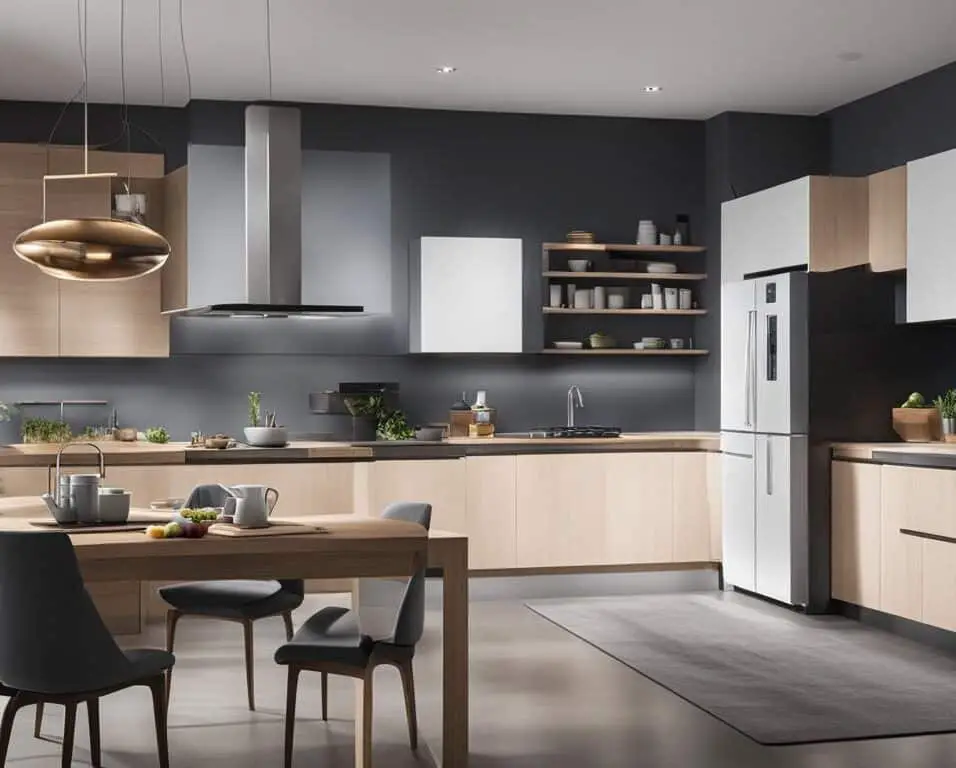Building a Connected Home with IoT
Welcome to the world of IoT, where the possibilities for a connected home are endless. Integrating IoT devices into our living spaces offers efficient smart home solutions that provide seamless connectivity and enhance our daily lives. Imagine a home where lights, appliances, security systems, and entertainment devices are seamlessly interconnected, providing convenience, comfort, and energy efficiency.
With the advent of AWS IoT, building a connected home has become easier than ever. AWS IoT offers a range of services and solutions specifically designed to help connected home device manufacturers build scalable IoT applications effortlessly. It provides a comprehensive platform for the collection, processing, analysis, and action on data generated by connected home devices, eliminating the need for managing complex infrastructure.
From home automation and voice enablement to home security and monitoring, the use cases for IoT in the connected home are vast. Many forward-thinking customers have already successfully implemented AWS IoT for their connected home products, experiencing reduced development time and costs, while delivering exceptional user experiences.
Are you ready to unlock the potential of a connected home? Let’s explore the future of smart homes and the impact of IoT on our quality of life.
Key Takeaways:
- Integrating IoT devices in the connected home offers efficient smart home solutions with seamless connectivity.
- AWS IoT provides a range of services and solutions to help connected home device manufacturers build scalable IoT applications.
- Use cases for IoT in the connected home include home automation, voice enablement, home security, and monitoring.
- Successful implementation of AWS IoT in connected home products reduces development time and costs.
The Future of Smart Homes: Embracing IoT
The IoT smart home device market is experiencing rapid growth, with sales forecasted to reach a staggering $53 billion by 2022. However, amidst discussions about sales and consumer adoption, we often overlook a crucial aspect: the actual impact of IoT on the quality of life in our homes.
While the integration of IoT into our homes is seen by many as inevitable, it is essential that we critically examine whether it truly enhances domestic life. Embracing IoT and integrating smart home devices brings both benefits and trade-offs that need to be carefully considered.
Let’s delve into the potential impact of IoT on our living spaces and explore the implications it may have on our everyday lives.
“The IoT smart home device market is expected to grow exponentially in the coming years. However, it is crucial that we carefully analyze the impact of these devices on our everyday lives.”
Enhancing Convenience and Efficiency
One of the key promises of IoT in smart homes is the potential to make our lives easier and more convenient. With IoT devices, we can automate various tasks such as controlling lights, adjusting temperatures, and managing security systems through a single interface. This convenience can save us time and energy, allowing us to focus on more meaningful activities.
Improving Energy Efficiency
IoT-enabled smart homes offer the opportunity to optimize energy consumption. Smart thermostats can learn our preferences and adjust heating and cooling accordingly, reducing energy waste. Connected lighting systems can automatically turn off lights in unoccupied rooms, minimizing electricity usage. By leveraging IoT technologies, we can create more sustainable living environments.
Enhancing Security and Safety
Smart home devices equipped with IoT capabilities can significantly enhance security and safety within our homes. From sophisticated surveillance systems that provide real-time alerts to smart locks that offer keyless entry, these devices provide peace of mind by allowing us to monitor and control access to our homes remotely.
Fostering Connectivity and Communication
IoT devices in smart homes enable seamless connectivity among different devices and systems. This interconnectedness allows us to create personalized and integrated experiences tailored to our specific needs. We can now control and manage our homes remotely, communicate with our devices through voice commands, and even interact with other smart home ecosystems.
The Trade-Offs: Privacy and Security Concerns
While IoT offers remarkable opportunities, it also raises valid concerns about privacy and security. With an increasing number of devices interconnected and collecting data, there is a need for robust safeguards to protect our personal information. Without proper security measures in place, the benefits of IoT in smart homes may come at the expense of our privacy and personal data.
As we embrace IoT in our homes, it is crucial to strike a balance between the advantages it offers and the potential risks it poses to our privacy and security.
“To make informed decisions about integrating IoT devices into our homes, we must carefully evaluate the benefits and trade-offs they bring to our daily lives.”
The Evolution of Home Automation
The movement towards automated homes can be traced back to the introduction of electricity, which revolutionized the way we live. With the advent of electricity, new possibilities emerged, allowing for the creation of innovative devices that transformed the concept of home automation.
Automated homes began to take shape with the implementation of light bulbs, which provided a convenient way to illuminate our living spaces. This invention paved the way for the development of other electrical appliances that further enhanced our daily lives. From electric ovens and refrigerators to washing machines and vacuum cleaners, these appliances introduced increased convenience and efficiency into our homes.
As these technologies evolved, so did the concept of home automation. The promise of automated homes was enticing – the ability to control various aspects of our homes with ease, improving performance and saving time. With the integration of IoT devices, homes have become smarter and more interconnected than ever before.
However, along with the convenience and efficiency comes concerns about privacy and security. With the proliferation of IoT devices in smart homes, there is a growing need to address these issues. The interconnectedness of devices raises questions about who has access to our personal information and whether our homes are truly secure.
Privacy and security are fundamental aspects of our lives, especially within the sanctity of our homes. It is essential to consider what we are willing to sacrifice in exchange for the convenience and automation that IoT devices bring. Striking the right balance between functionality and safeguarding our privacy is crucial for the future of home automation.
The Tipping Point for IoT Adoption in Homes
The adoption of IoT in homes has been slower compared to smartphones. While the release of the iPhone in 2007 triggered a significant shift in smartphone adoption, thanks to its user-friendly interface, IoT devices have faced resistance from consumers. One of the main reasons behind this resistance is the lack of cohesive integration among different smart home devices and apps, resulting in a fragmented user experience.
Unlike smartphones, which offer a seamless ecosystem with interoperability between various applications, smart home devices often require separate apps and systems to operate. This fractured landscape makes it challenging for users to navigate and control their smart home devices effectively.
“The lack of a unified platform for smart home devices hinders the adoption of IoT in homes. Users desire a user-friendly interface that allows them to operate all their smart home devices seamlessly from one central hub.”
Imagine having to switch between different apps to control your lights, thermostat, and security system. This fragmented experience not only complicates the user interface but also prevents the full potential of IoT from being realized in our homes. To drive IoT adoption in homes, a breakthrough is needed—a home integration hub that provides a seamless interface, simplifying device interaction, and offering a truly connected experience.
This home integration hub would serve as a central control panel for all smart home devices, allowing users to manage and operate their devices from a single platform. It would enable users to set up automations, manage schedules, and receive notifications—all from one convenient location.
By implementing such a hub, users can experience the convenience of controlling all their smart devices effortlessly, leading to increased adoption and acceptance of IoT in homes. The need for a user-friendly interface that unifies the smart home experience cannot be overstated; it is the key to unlocking the potential of connected living.
Benefits of a User-Friendly Interface in IoT Adoption:
- Simplified device management and control
- Streamlined user experience for increased convenience
- Reduced complexity and frustration for users
- Improved interoperability and compatibility between devices
A Comparison of IoT Adoption and Smartphone Adoption
| IoT | Smartphones | |
|---|---|---|
| Adoption Rate | Slow | Rapid |
| Integration | Lack of cohesive integration | Seamless ecosystem |
| Interface | Fragmented user experience | User-friendly interface |
| Implication | Resistance to IoT adoption | Swift and widespread adoption |

With a user-friendly interface and a simplified smart home experience, IoT adoption can reach its tipping point. The development of a home integration hub has the potential to revolutionize the way we interact with smart home devices, making our homes truly connected and enhancing our lives with the power of IoT.
Making Smart Home Apps a Reality
Smart home apps play a crucial role in the seamless management of IoT devices, enabling users to control various aspects of their homes, including lights, temperature, security, and entertainment, directly from their smartphones or tablets. Leveraging IoT technology, these apps create a centralized control center, allowing homeowners to easily connect and synchronize their smart devices.
With the increasing popularity of smart home automation, these apps offer numerous benefits. Firstly, they provide convenience and flexibility, enabling users to control their homes remotely, even when they are away. For example, homeowners can adjust the thermostat and turn on the lights before returning home, creating a comfortable environment upon arrival.

Smart home apps empower users with control over their homes, making everyday tasks more efficient and convenient.
In addition to convenience, smart home apps contribute to energy efficiency. By offering features such as scheduling and energy monitoring, users can optimize energy usage and reduce their carbon footprint. For example, homeowners can schedule the heating or cooling to automatically adjust based on occupancy, resulting in energy savings without compromising comfort.
Data security is a significant concern when it comes to smart homes and IoT devices. Smart home apps must prioritize the protection of user data and ensure secure communication between the app and connected devices. Robust encryption protocols and authentication mechanisms are essential to safeguarding personal information and preventing unauthorized access.
When it comes to developing a smart home app, there are several factors that influence the cost. The complexity of features, platform compatibility (iOS, Android, etc.), app design, integration with other devices and services, data security requirements, and the location and expertise of the developers all play a role in determining the overall development cost.
To give you a better understanding, here is a breakdown of the factors affecting the cost of smart home app development:
| Factors Affecting App Development Cost | Details |
|---|---|
| Complexity of Features | The number and complexity of features integrated into the app, such as device control, scheduling, notifications, and integration with third-party services. |
| Platform Compatibility | The app’s compatibility with different platforms, including iOS and Android, which may require additional development and maintenance efforts. |
| App Design | The design elements and user interface (UI) of the app, including aesthetics, usability, and intuitiveness. |
| Integration with other devices and services | The level of integration required with other smart devices and services, such as voice assistants or home security systems. |
| Data Security | The implementation of robust security measures to protect user data, including encryption, authentication, and secure communication protocols. |
| Developer Expertise and Location | The experience, skills, and location of the development team, which can impact the overall cost. |
Considering these factors during the planning and development stages can help optimize the development process and ensure the creation of a high-quality smart home app that meets user expectations.
Steps to Develop a Smart Home App
Developing a smart home app involves a systematic process that encompasses various stages. Each step is crucial for creating a successful app that meets the needs of users. Here are the key steps involved in the development process:
1. Define the Function and Features
Firstly, it is essential to clearly define the function and features of the smart home app. This involves determining the core purpose and identifying the specific capabilities that the app should offer. Understanding the target audience and their requirements is vital for crafting a user-centric app.
2. Conduct Market Research
Prior to proceeding with development, conducting thorough market research is crucial. This helps to identify trends in the smart home industry, analyze competitors’ offerings, and gain insights into consumer preferences. By understanding the market landscape, it becomes easier to develop a unique and competitive app.
3. Design the User Interface and User Experience
The user interface (UI) and user experience (UX) design play a significant role in the success of a smart home app. Creating an intuitive and visually appealing interface enhances usability and engages users. Collaborating with experienced UI/UX designers ensures a seamless and enjoyable user experience.
4. Backend and Frontend Development
Backend development involves building the server-side components of the app that handle data processing, storage, and connectivity with IoT devices. Frontend development focuses on creating the client-side interface that users interact with. Collaborating with skilled developers proficient in both backend and frontend technologies is essential for creating a robust and user-friendly app.
5. Testing and Troubleshooting
Thorough testing is a critical step in app development. It involves identifying and resolving any bugs or issues to ensure a smooth and error-free user experience. Rigorous testing should be performed across multiple devices and platforms to ensure compatibility and reliable functionality.
6. Provide Ongoing Support and Maintenance
Once the smart home app is developed and launched, providing ongoing support and maintenance is crucial. This includes monitoring app performance, addressing user feedback and issues, and regularly updating the app to incorporate new features and improvements. Timely support and maintenance ensure a positive user experience and help maintain the app’s reputation in the market.
Throughout the app development process, collaboration between designers, developers, and stakeholders is essential for achieving a successful outcome. By following these steps, developers can create a smart home app that delivers seamless connectivity and enhances the quality of life for users.
| Steps to Develop a Smart Home App | Description |
|---|---|
| Define the Function and Features | Clearly define the core purpose and specific capabilities of the app. |
| Conduct Market Research | Thoroughly research the smart home market, competitors, and user preferences. |
| Design the User Interface and User Experience | Create an intuitive and visually appealing UI/UX to enhance user engagement. |
| Backend and Frontend Development | Develop the server-side components and client-side interface of the app. |
| Testing and Troubleshooting | Rigorously test the app for bugs and issues to ensure a smooth user experience. |
| Provide Ongoing Support and Maintenance | Monitor app performance, address user feedback, and regularly update the app. |
Conclusion
Smart home apps play a crucial role in automating and managing various aspects of our homes. With features such as device control, voice control, schedule timers, remote access, push notifications, and integration with third-party devices and services, these apps offer convenience and efficiency in home management.
By embracing IoT and integrating smart home devices, we can transform our living spaces into efficient and connected environments. Smart home automation has the potential to enhance comfort, energy efficiency, and security in our homes.
The future prospects of smart home automation are promising. As technology continues to advance, we can expect even more innovative features and seamless integration between devices. The integration of smart home devices and apps opens up new possibilities for home automation, making our lives easier and more convenient.
In conclusion, the benefits of smart home automation and the features offered by smart home apps make them essential tools for modern living. As we embrace the potential of IoT, we can create a future where our homes are optimized for comfort, efficiency, and security.
FAQ
What services does AWS IoT offer for building a connected home with IoT?
AWS IoT offers a range of services and solutions to help connected home device manufacturers easily build scalable IoT applications. It allows for the collection, processing, analysis, and action on data generated by connected home devices without having to manage infrastructure.
What are the use cases for IoT in the connected home?
Use cases for IoT in the connected home include home automation and voice enablement, home security and monitoring, and home network management.
Have customers successfully implemented AWS IoT for their connected home products?
Yes, several customers have successfully implemented AWS IoT for their connected home products, reducing development time and costs.
How much is the IoT smart home device market projected to reach by 2022?
The IoT smart home device market is projected to reach $53 billion by 2022.
Does the adoption of IoT into our homes truly improve domestic life?
The actual impact of IoT on the quality of life in our homes is a subject of discussion and examination, as the adoption may not be inevitable. It is important to consider the benefits and trade-offs of integrating IoT devices into our living spaces.
What concerns arise with the proliferation of IoT devices in smart homes?
Concerns about privacy and security arise with the proliferation of IoT devices in smart homes. It is important to consider what is being offered in exchange for the potential compromise of privacy and security in our most personal space.
Why has the adoption of IoT in homes been slower compared to smartphones?
The adoption of IoT in homes has been slower compared to smartphones due to a lack of cohesive integration among different smart home devices and apps which results in a fragmented user experience.
What is needed to drive IoT adoption in homes?
The development of a home integration hub that provides a seamless interface and simplifies device interaction will be crucial in driving IoT adoption in homes.
What do smart home apps do?
Smart home apps serve as the control center for IoT devices, allowing users to manage and control lights, temperature, security, and entertainment from their smartphones or tablets.
What factors affect the cost of developing a smart home app?
The cost of developing a smart home app depends on factors such as the complexity of features, platform compatibility, app design, integration with other devices and services, data security, and the location and expertise of the developers.
What are the steps involved in developing a smart home app?
The development of a smart home app involves several steps, including defining the app’s function and features, conducting market research, designing the user interface and user experience, developing the backend and frontend, testing and troubleshooting, and providing ongoing support and maintenance.
What features do smart home apps offer?
Smart home apps offer a range of features such as device control, voice control, schedule timers, remote access, push notifications, and integration with third-party devices and services.
What are the benefits of smart home automation?
Smart home automation makes life easier, more convenient, and efficient by automating various aspects of home management such as lighting, temperature control, security, and entertainment.
What is the future of smart home automation?
The future of smart home automation looks promising, with the potential to enhance comfort, energy efficiency, and security in our living spaces. Embracing IoT and integrating smart home devices can revolutionize our homes into efficient and connected living spaces.








